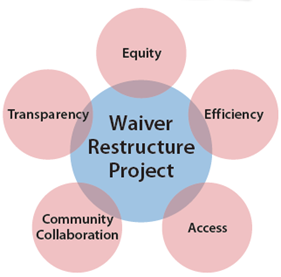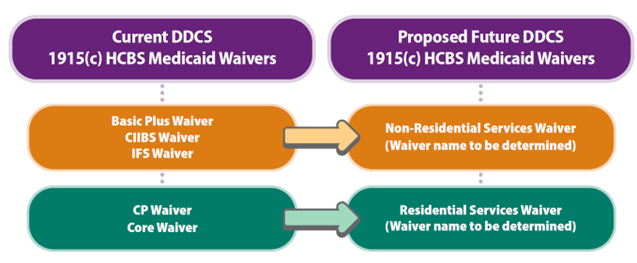
Developmental Disabilities Community Services Division shared the Medicaid 1915 (c) Waiver Restructure report to the legislature on Dec. 1, 2024. The report includes suggestions for making the waiver service system better.
To achieve these principles the project teams created opportunities for collaboration and feedback from waiver participants and their families, DSHS DDCS staff, and community partners. The recommendations came from more than 1,800 comments. The teams considered the feedback and input from each group and responded with a design that incorporated and built upon those ideas. Our waiver restructuring goals align DDCS with the Department of Social and Health Services’ mission, vision and values of increasing access to services, improving community collaboration and efficiency and upholding equity and transparency.

The Waiver Restructure report recommendations include improving the service structure and consolidating from the current five waivers to two waivers. Participants will enroll in these waivers based on the living situation a person wants and needs.
Waiver redesign timeline and updates
- Service design, rates and service amount assessment.
- Research and Data Analysis Division finalize algorithms for rates and service amounts.
- Division of Information Technology will build the Research and Data Analysis Division algorithms into the CARE assessment tool.
Additional updates
July 2025
- Agency requested provider rate increases took effect July 1, 2025 for:
- Community engagement
- Life skills
- Peer mentoring
- Respite in the community
- Select agency respite provider setting types
- Residential habilitation services
- See Management Bulletin D25-004 – Waiver Service Rate Increase and Gov Delivery Message for more information.
- DDCS regional resource developers sent rate increase notices to potential providers who previously declined a contract due to insufficient rate.
- Waiver redesign workgroups began:
- Internal subject matter experts identified, and meetings scheduled for system change feasibility, resource needs, service change evaluation and feasibility.
- Community Collaboration website design drafted. Website will provide updates and seek information from the public on waiver redesign.
August 2025
- Waiver redesign workgroups that started in July continue.
- Community collaboration workgroup listening sessions begin, many on a monthly basis. Groups include:
- Legislative Report Community Collaborators
- Family Advisory Council
- Self-Advocates Advisory Council
- Providers
- DDCS Field Staff
- Research on the feasibility of combining some services. DDCS asked the Centers for Medicare and Medicaid Services to clarify technical guidance on service bundling, specifically to combining assistive technology, specialized equipment and supplies, transportation, and other services. CMS responded with reference to HCBS technical guide that describes limitations on service bundling. Conversations with CMS about service structure is ongoing.
September 2025
Waiver redesign September 2025 updates
- The Centers for Medicare & Medicaid Services clarified that combining services can only be done for closely related services, and we must demonstrate that combining services improves quality, reduces cost, and maintains participant choice. Services with significantly different intents (for example, assistive technology and waiver transportation) cannot be combined into one service as requested by community collaborators, but services that are similar and meet the requirements mentioned above, can be combined. Decisions and Findings:
- When the waivers are combined and services change, the transition will need to happen over a 12-month period. The transition will begin either at a person’s annual assessment or by request. We cannot roll out the waivers all at once, because the CARE assessment tool cannot auto-populate all the person-centered service amounts in each person’s plan.
- Community collaboration workgroup listening sessions continue. Many of these workgroups continue to meet monthly. Groups include:
- Survey Information:
- In person National Core Indicators survey has been completed. Information from this survey will be used to inform upcoming waiver redesign service planning workgroups.
- Service design:
- Internal review of service plans and authorizations completed after some prior approvals were removed for assistive technology and specialized equipment under $550. This data will inform service design for redesigned waiver goods service(s).
October 2025
- A project manager has been assigned to assist with waiver redesign project with documentation and consultation.
- Workgroups are meeting to determine how much time and what resources will be needed to update DDCS systems for the waiver redesign.
- Change timeline: Workgroups determined that the changes required to DDCS systems (i.e. the CARE assessment tool) will take 3-4 years after service design is finalized. The roll out to consolidate from 5 waivers to 2 waivers will not begin September 2027. An updated timeline will be posted soon.
- Project risk identified: Provider recruitment and contracting for new services will require additional funding and additional staff to support recruiting a diverse and sustainable provider network.
- Community collaboration workgroup listening sessions (many of these workgroups continue to meet monthly). The community collaboration work group will start organizing feedback by collaborator type to provide greater detail regarding advocacy. This will help highlight the priorities between groups such as people with lived experience, their family members and providers.
- Groups include:
- Legislative Report Community Collaborators
- Family Advisory Council and Regional Advisory Council
- Self-Advocates Advisory Council
- Providers and counties
- DDCS Field Staff
- Groups include:
Biweekly DDCS service design workgroups are incorporating feedback from the community
Stay in Touch
DSHS DDCS is committed to continuing to include input from people with lived experience to implement services that meet their needs. If you are interested in getting involved, please see our Community Collaborators page for more information.
An additional way to provide feedback is by emailing responses to the waiver redesign inbox and completing surveys that we will post here throughout our redesign process. The first survey will be posted soon.
The first question for our shared inbox is for people who receive DDCS services (an advocate can also help submit an answer):
If you need support with personal care tasks, such as eating, mobility, toileting, or other hygiene tasks while in your community, who would you rather receive support with your personal care from? Please send your response to DDCSWaiverRedesign@dshs.wa.gov
Feedback for this question will close after November 2025.
